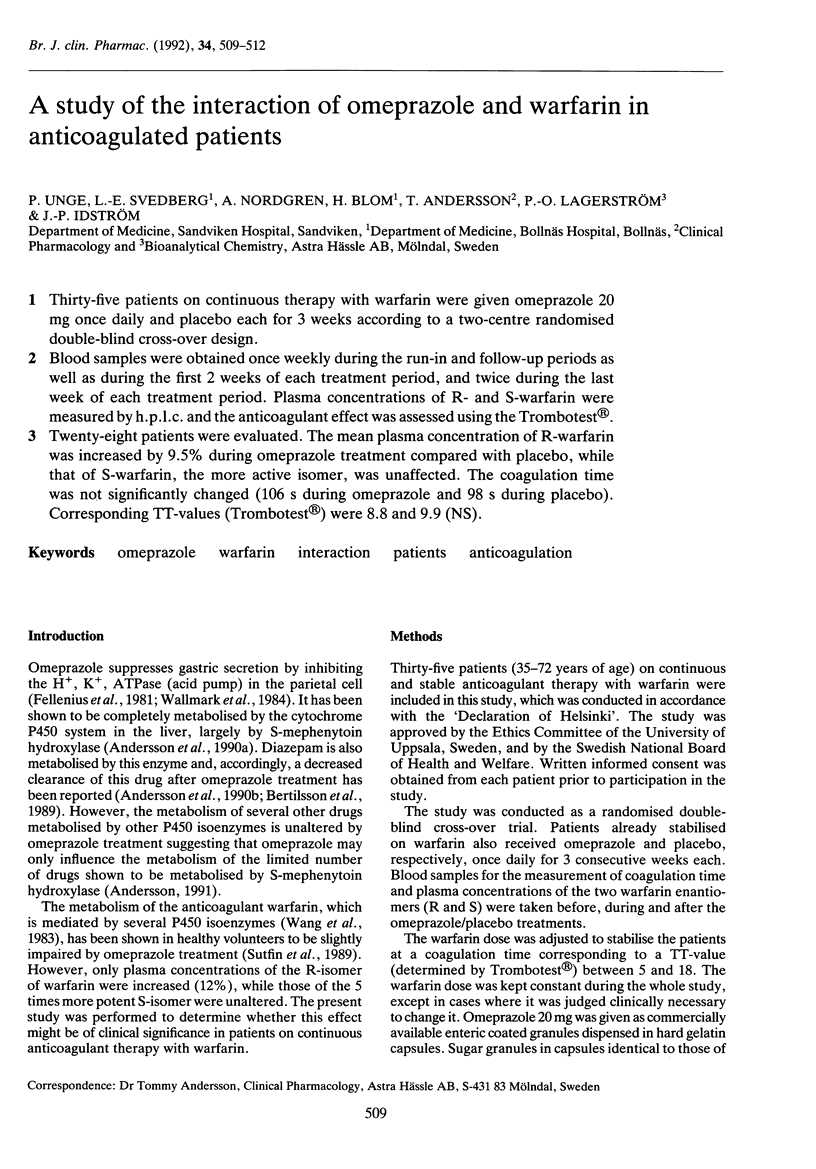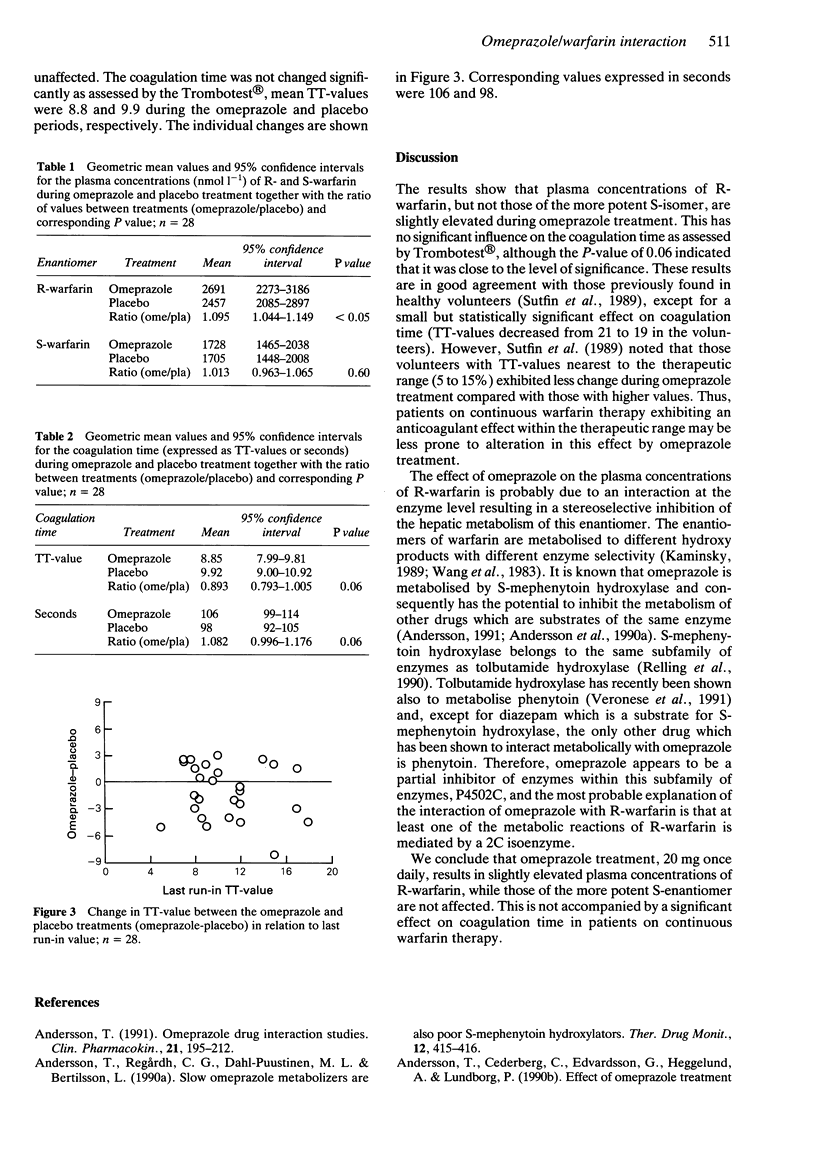Abstract
1. Thirty-five patients on continuous therapy with warfarin were given omeprazole 20 mg once daily and placebo each for 3 weeks according to a two-centre randomised double-blind cross-over design. 2. Blood samples were obtained once weekly during the run-in and follow-up periods as well as during the first 2 weeks of each treatment period, and twice during the last week of each treatment period. Plasma concentrations of R- and S-warfarin were measured by h.p.l.c. and the anticoagulant effect was assessed using the Trombotest. 3. Twenty-eight patients were evaluated. The mean plasma concentration of R-warfarin was increased by 9.5% during omeprazole treatment compared with placebo, while that of S-warfarin, the more active isomer, was unaffected. The coagulation time was not significantly changed (106 s during omeprazole and 98 s during placebo). Corresponding TT-values (Trombotest) were 8.8 and 9.9 (NS).
Full text
PDF



Selected References
These references are in PubMed. This may not be the complete list of references from this article.
- Andersson T., Cederberg C., Edvardsson G., Heggelund A., Lundborg P. Effect of omeprazole treatment on diazepam plasma levels in slow versus normal rapid metabolizers of omeprazole. Clin Pharmacol Ther. 1990 Jan;47(1):79–85. doi: 10.1038/clpt.1990.12. [DOI] [PubMed] [Google Scholar]
- Andersson T. Omeprazole drug interaction studies. Clin Pharmacokinet. 1991 Sep;21(3):195–212. doi: 10.2165/00003088-199121030-00004. [DOI] [PubMed] [Google Scholar]
- Andersson T., Regårdh C. G., Dahl-Puustinen M. L., Bertilsson L. Slow omeprazole metabolizers are also poor S-mephenytoin hydroxylators. Ther Drug Monit. 1990 Jul;12(4):415–416. doi: 10.1097/00007691-199007000-00020. [DOI] [PubMed] [Google Scholar]
- Bertilsson L., Henthorn T. K., Sanz E., Tybring G., Säwe J., Villén T. Importance of genetic factors in the regulation of diazepam metabolism: relationship to S-mephenytoin, but not debrisoquin, hydroxylation phenotype. Clin Pharmacol Ther. 1989 Apr;45(4):348–355. doi: 10.1038/clpt.1989.40. [DOI] [PubMed] [Google Scholar]
- Fellenius E., Berglindh T., Sachs G., Olbe L., Elander B., Sjöstrand S. E., Wallmark B. Substituted benzimidazoles inhibit gastric acid secretion by blocking (H+ + K+)ATPase. Nature. 1981 Mar 12;290(5802):159–161. doi: 10.1038/290159a0. [DOI] [PubMed] [Google Scholar]
- Kaminsky L. S. Warfarin as a probe of cytochromes P-450 function. Drug Metab Rev. 1989;20(2-4):479–487. doi: 10.3109/03602538909103554. [DOI] [PubMed] [Google Scholar]
- Relling M. V., Aoyama T., Gonzalez F. J., Meyer U. A. Tolbutamide and mephenytoin hydroxylation by human cytochrome P450s in the CYP2C subfamily. J Pharmacol Exp Ther. 1990 Jan;252(1):442–447. [PubMed] [Google Scholar]
- Sutfin T., Balmer K., Boström H., Eriksson S., Höglund P., Paulsen O. Stereoselective interaction of omeprazole with warfarin in healthy men. Ther Drug Monit. 1989;11(2):176–184. doi: 10.1097/00007691-198903000-00010. [DOI] [PubMed] [Google Scholar]
- Veronese M. E., Mackenzie P. I., Doecke C. J., McManus M. E., Miners J. O., Birkett D. J. Tolbutamide and phenytoin hydroxylations by cDNA-expressed human liver cytochrome P4502C9. Biochem Biophys Res Commun. 1991 Mar 29;175(3):1112–1118. doi: 10.1016/0006-291x(91)91680-b. [DOI] [PubMed] [Google Scholar]
- Wallmark B., Brändström A., Larsson H. Evidence for acid-induced transformation of omeprazole into an active inhibitor of (H+ + K+)-ATPase within the parietal cell. Biochim Biophys Acta. 1984 Dec 19;778(3):549–558. doi: 10.1016/0005-2736(84)90406-1. [DOI] [PubMed] [Google Scholar]
- Wang P. P., Beaune P., Kaminsky L. S., Dannan G. A., Kadlubar F. F., Larrey D., Guengerich F. P. Purification and characterization of six cytochrome P-450 isozymes from human liver microsomes. Biochemistry. 1983 Nov 8;22(23):5375–5383. doi: 10.1021/bi00292a019. [DOI] [PubMed] [Google Scholar]


